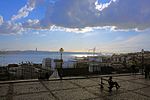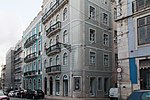Verride Palace
Buildings and structures completed in the 18th centuryHotel buildings completed in 2017Palaces in Lisbon

Verride Palace, or the Palace of Santa Catarina, (Portuguese: Palácio de Verride; Palácio de Santa Catarina) is an 18th-century Portuguese palace located in Lisbon, Portugal.
Excerpt from the Wikipedia article Verride Palace (License: CC BY-SA 3.0, Authors, Images).Verride Palace
Rua de Santa Catarina, Lisbon
Geographical coordinates (GPS) Address Phone number Website External links Nearby Places Show on map
Geographical coordinates (GPS)
| Latitude | Longitude |
|---|---|
| N 38.7098 ° | E -9.147 ° |
Address
Verride Palácio de Santa Catarina (Palácio do Conde de Verride;Palácio de Santa Catarina;Palácio Santiago-Prezado)
Rua de Santa Catarina 1
1200-401 Lisbon
Portugal
Open on Google Maps








